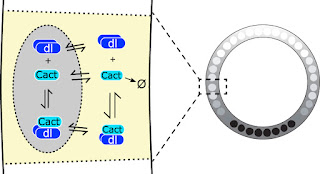 |
| In the early Drosophila embryo, Dorsal (Dl) is present at high levels on the ventral side (black nuclei on right). This gradient is established by the action of Toll signaling on the ventral and lateral parts of the embryo (not shown) causing Cactus (Cact), the inhibitor for Dorsal, to split up from Dorsal and be degraded (left). Previously, it had not been proposed that Cactus or Dorsal/Cactus complex could enter the nuclei (left). For more on Dorsal, Cactus, and Toll, see here. |
This idea had not been proposed before (at least, not at this stage in Drosophila development), and reviewers were suspicious. We even had a reviewer of a subsequent manuscript try to reject that manuscript because of the assumptions we made in the 2015 paper!
Now, given that we have a wet lab, one way to test our assumptions would be to simply perform well designed experiments. But sometimes, that's easier said than done. In this particular case, because Cactus is difficult to image (both in fixed embryos, but also in live imaging), all of the proposed experiments would be indirect validations of our results, at best.
So the question is: do we actually need to validate these assumptions? That's not as radical of a question as it might sound at first. I am basically asking: weren't the assumptions already validated by the fact that the model provided a better explanation of previous data? This the question that we'll begin to look at next time.
No comments:
Post a Comment